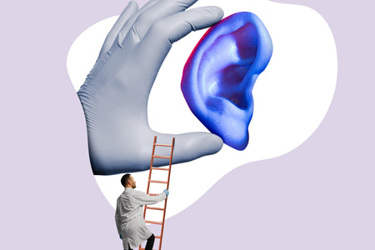Regeneron's Strategy To Address Congenital Deafness

By Tyler Menichiello, Chief Editor, Bioprocess Online

It’s hard not to get excited about gene therapies that restore patients’ senses (e.g., gene therapies to treat blindness), which is why I was eager to learn more about Regeneron’s investigational gene therapy for patients with congenital hearing loss, DB-OTO. This AAV-based gene therapy, originally developed under a collaboration between Regeneron and Decibel Therapeutics before Regeneron acquired Decibel, is for patients with an otoferlin (OTOF) gene mutation.
I met with the DB-OTO global program head at Regeneron, Jonathon Whitton, Au.D., Ph.D., and SVP of research, Christos Kyratsous, Ph.D., to discuss DB-OTO and the company’s clinical and developmental strategy. Though DB-OTO is being developed for patients with a rare disease, the company sees it as a launchpad into other types of genetic deafness and more broadly, multifactorial (e.g. age-related or noise-induced) hearing loss that affects millions of people.
Starting In Pediatrics
It’s rare for a first-in-human study to be done with young patients, but when it comes to genetic deafness, you want to be able to treat it as early as possible, Whitton says. “Regulators agreed with us that it made the most sense to actually start clinical development in a pediatric patient population,” he says, based on compelling preclinical safety and efficacy data.
Children can see the biggest benefit from this type of therapy compared to adults who have lived with it their whole life, especially if these children receive treatment within their first year, when their brain is developing speech and language abilities. Back in May, an 11-month-old was dosed with DB-OTO as part of the ongoing Phase 1/2 CHORD study — one of the youngest patients to ever receive a gene therapy for genetic deafness.
While DB-OTO isn’t the only gene therapy being developed for congenital deafness, from a clinical standpoint, Regeneron is navigating “totally uncharted territory,” says Kyratsous. “We are all learning together to determine how best to approach it,” he says. There have been a lot of discussions between Regeneron, regulatory agencies, and clinicians on how to utilize this therapy and treat patients who need it the most.
Despite the challenges, Whitton and Kyratsous believe starting with the highest regulatory bar (i.e., treating pediatric patients) will make subsequent development easier, as many of the learnings from DB-OTO and the CHORD study can be extrapolated and applied to other programs.
The Need For More Genetic Testing
Finding patients for the CHORD trial means working with clinical sites and centers who are engaged in early genetic testing to diagnose hearing loss, Whitton explains. This genetic testing isn’t typically done in clinical practice because, without any approved therapies, it doesn’t provide actionable information.
“There are no therapies,” Kyratsous explains. “Even if you identify that child X has this kind of mutation, there’s nothing you can do about it. So, what’s the point of doing the genetic testing?”
Of course, Regeneron and others are hoping to change that.
“We’re essentially working with the clinical community on changing the practice of medicine,” Whitton says, which I think aptly conveys the excitement shared by everyone in the gene therapy space.
“In the coming years, one should expect that clinicians, more broadly, will start engaging in early diagnosis for patients if we start having therapeutics that can be available,” he continues.
Modality Agnostic Development
DB-OTO utilizes an AAV-1 capsid, a decision that was made based on the demonstrated preclinical safety and ability to transduce tissues in the inner ear, Whitton explains. This particular capsid can transduce a number of cells in the inner ear, which makes it useful to build a platform around.
“That was the thinking at the time about it was, number one, it has to be great for the first thing you take into the clinic. And then two, do you have flexibility to potentially reuse some of the technology to plug-and-play a little bit around other forms of hearing loss?” he says.
This forward thinking about how to build off of the DB-OTO technology and expand into other types of deafness (whether genetic or multifactorial) highlight’s the company’s overarching, modality-agnostic approach to drug development.
“The number one principle at Regeneron is to try to understand the biology,” Kyratsous tells me, “and it usually starts with genetics. We are very strong believers that having a genetic clue about either a biological pathway or a way to intervene in a specific biological pathway is what’s going to be the start of a program.”
Following this philosophy, the company looks at biology to determine the most appropriate modality for a specific indication. Taking this scientific understanding and marrying it with the most effective modality is the guiding light that unifies Regeneron’s diverse pipeline of therapeutics and indications, Whitton says.
“We’re going to take the best science, and we’re going to match it to the biggest impact in human beings,” he tells me.
As companies like Regeneron continue to learn from biology and develop ATMPs, the industry is sure to see expansion into more common and prevalent conditions. Every successful program brings us one step closer to triumphing over disease and blurs the lines between modern medicine and science fiction.
